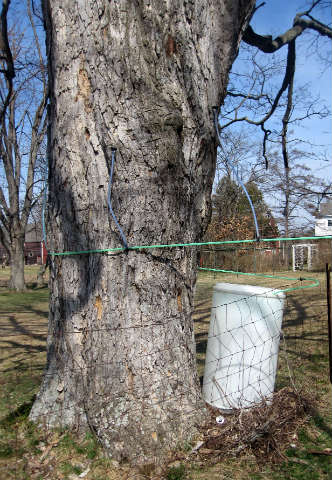
Gathering sap in a Connecticut sugarbush
In agriculture patience is a virtue, and producing luscious, sweet maple syrup is the embodiment of that patience.
Growing up in Connecticut, I was lucky to be raised on 100% pure maple syrup and never had Aunt Jemima’s pancake syrup until I was a teenager. Maple syrup comes predominantly from the sap generated by sugar maple (Acer saccharum) or black maple (Acer nigrum) trees and is grown across the northern tier of the eastern United States and eastern Canada. Pancake syrup is a mixture of corn syrups, caramel color, salt, artificial and natural flavors and other ingredients I would not serve on my breakfast table. No wonder I can taste the difference.
Producing maple syrup is one of the simplest but also most complicated sugar treats. The 2012 maple syrup season tested the patience and perseverance of the farmer.
Maple syrup had its start prior to the white man coming to this country, when the Native Americans tapped trees and added the liquid sap to stews and roasts. The act of cooking the meat evaporated the water and left a sugary syrup in the meal. The New England settlers refined the process to create the stand-alone maple syrup product that is revered and sold today.

Collecting maple sap with the tubing system
Syrup production begins in the dark of winter, when farmers trudge out into the snow to tap their trees, place their buckets or connect their trees via plastic tubing that drain to a main collection spot. Improvements to sap collection, such as vacuum systems, have been made by the larger farmers, but for most, gravity methods prevail.
Trees in the sugar bush, the collection of maple trees, are tapped when they are a minimum of 12 inches in diameter and have already lived for 30 to 40 years. Now that’s what you call patience and perseverance: waiting almost two generations for a tree to be ready for production in our “want it now society.” Trees are known to produce for at least 100 years.
Knowing when to tap is a science, but also an intuition. Tree sap flows when the daytime temperatures are over 40 degrees Fahrenheit but the nights are still below freezing. Once the trees bud, sap collection stops, because the change in hormones in the tree alters the sap’s flavor.

Inside the sugar house
Sap is gathered and placed in the sugar house in large evaporator pans that boil the sap until it is 7-1/2 degrees Fahrenheit above the boiling temperature of water. The sugar house is a structure that is built specifically for maple syrup production on a family farm. It takes 30 to 40 gallons of sap to produce one gallon of syrup.
The syrup process is completed in the finishing pan, filtered and color-graded with Grade A Light Amber, the premium product. Producing maple syrup has simple instructions, but it is an art to do it right.
An early spring in Connecticut
In the middle of March, I got to see the end of the sugar season. Connecticut had a week of record-setting temperatures and no nighttime freezes, which cut the optimal two-month season short.
It wasn’t until I explored the stately maple tree and its gifts to our dining tables that I really learned that patience is a virtue and sweetness is its cousin.
Kathryn Gardow, P.E., is a land use expert and owner of Gardow Consulting, an organization dedicated to providing multidisciplinary solutions to building sustainable communities. Kathryn has expertise in project management, planning, and civil engineering, with an emphasis on creating communities that include food production.

